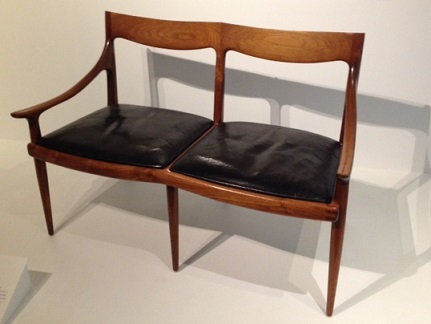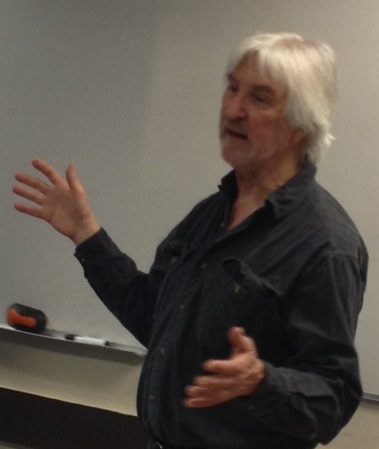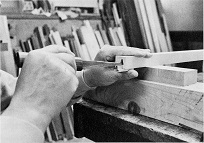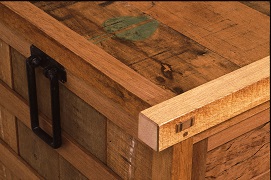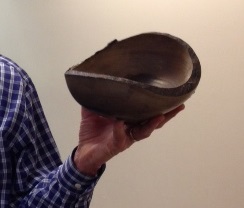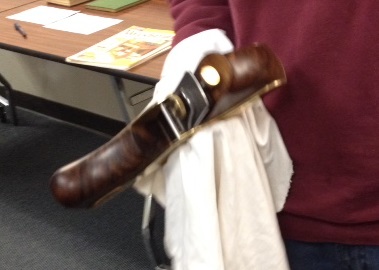ON THE ROAD
Tales of the Southeast
I recently did a couple of woodworking shows at the other end of the country;
one in Richmond, Virginia and one in Miami. I also did Richmond last year,
so I knew what to expect and there were no surprises. Woodworking is
semi—comatose there, however, drugs are doing quite well and when I was there
the top news story was the city's high murder rate. Miami, on the other
hand, was new to me, so I had no expectations. It would be safe to say that
woodworking in Miami, like Richmond, appears to be in something of a developmental
stage. No, that's not it. Actually, they bypassed the developmental stage,
and the refinement stage, and went straight to the particleboard stage.
In a certain technological sense, you could say that they're in an advanced stage
of woodworking. There's another type of woodworking going on in south Florida
that I call hunter-gatherer woodworking. Apparently, quite a bit of wood
washes up on the shores of that area and a certain segment of practicing
woodworkers use the water's edge as a source of supply. I guess moisture
content isn't a big concern.
As far as wood from the lumber company goes, folks in south Florida go for
what they described as "light" woods. At first, I connected this with light
beer and other insipid things, but it was explained to me that they meant
wood that was both light in color and weight, not low in calories. We're
talking poplar and white pine, a species which thrives in the east.
Strangely enough, in the midst of all this particleboard and light wood, I
found, when I took a drive out to Key West, that lignum vitae and cocobolo
grow wild in the Florida keys. The keys, by the way, are quite beautiful
if you like chains of islands, and the vegetation is very different from what
we see in most other parts of the land. Mangrove seems to be the predominant
green growing thing. It's hard to say what it is, however. It's too small
to be a tree and doesn't look like a bush. It's somewhere in between and has
no principal trunk or stem. Instead, all the green part is supported by a
massive tangle of aerial roots that grow directly into the water.
Actually, mahogany grew in abundance at one time in southern Florida, but thanks to
unbridled commercial harvesting during the last century and the early part
of this one, the trees have basically been wiped out. On a side trip which
I took through the everglades, I ran across a small protected area about the
size of a baseball infield, in which was exhibited, sadly, the largest living
mahogany tree in the United States, a rather pathetic specimen of unnoteworthy
proportions. It also appeared to be about the only one left. Actually, the
notion that the everglades is a protected area is rather ludicrous, since
much of the water that made the place what it once was, a vast, lush subtropical
swamp teeming with all manner of life, has been permanently rerouted to serve
the expanding nearby agricultural areas and to quench the thirst of the
burgeoning population of Miami, about two thirds of which doesn't speak English
and the remaining one third speaks it with a New York accent.
I had a very nice visit, however, with Tom Wahlgren, a fellow who does
woodworking on Big Pine Key, one of the islands out near the end of the chain.
Tom's shop consists of two bays in an industrial building, of which there
aren't many in the keys. The woodworking done in this area is primarily
residential and includes a lot of straightforward cabinetmaking. Plastic
laminate work is popular and seems to blend well with the area's casual, low
maintenance way of life. High humidity is a big problem here, not only from
a comfort standpoint, but also because the moisture-laden air, combined with
temperatures that never drop below 40 (it was in the 80's when I was there,
the first week in March) takes a heavy toll on wood that isn't well protected,
and the generous amount of Sun proves to be an effective natural bleaching
agent.
Woodworkers are casual folks in south Florida. Shorts and tee shirts are
pretty much the uniform of choice and it's quite common to not work during
the hottest part of the day. The typical client of a woodworker is someone
who is moving down from the north, often the newly retired, and before moving,
engages a local contractor to build them a house. Much of the work, therefore,
is done through contractors, rather than directly with the owner. Tom explained
that much of the bread and butter jobs are the result of having a good
subcontract arrangement with one or more local contractors.
In general, woodworking hasn't been fully discovered in Florida, which is
understandable since the primary activities seem to be fishing, going to
the beach and dodging the Federal narcotics officers, not necessarily in that
order. In the "secured" parking lot of the Howard Johnson (yuk!) hotel where
I stayed in Miami, the primary activity was theft. Alligator hunting also
seems to be popular, which may explain why there are hardly any of the creatures
left. Environmentally, Florida performed a lobotomy on itself long ago and
is missing some major areas of consciousness. Fortunately, there are 49 other
states where they have no jurisdiction. Richmond, Virginia, on the other
hand, which I was in a week later, is quite a different situation from a
woodworking standpoint, but that's another story for another time.
Peter Good



